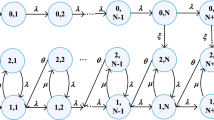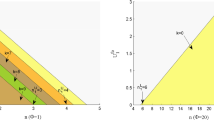Abstract
We consider a non-preemptive priority M/M/1 retrial queue with two classes of customers (low-priority and high-priority customers) and delayed vacations. When the server is unavailable, an arriving high-priority customer can wait in line, whereas an arriving low-priority customer needs to enter a virtual queue and retry later. After completing a service, the server will remain idle for a reserved idle time if it finds no high-priority customers in the system. Arrivals during the reserved idle period will be served immediately. Otherwise, if no customers arrive during this interval, the server will switch to the vacation state. By constructing a three-dimensional Markov chain, we successively obtain the stability condition of the system and some main performance measures. Then depending on a linear reward-cost structure, we derive customers’ two-dimensional equilibrium joining strategies in the fully unobservable case. Due to the complexity of the social welfare function, we explore the socially optimal joining strategies through the Particle Swarm Optimization (PSO) algorithm. Finally, we illustrate the impact of system parameters on the two types of joining strategies via numerical experiments.









Similar content being viewed by others
Data Availability Statement
The datasets generated during and/or analysed during the current study are available from the corresponding author on reasonable request.
References
Artalejo JR, Gómez-Corral A (2008) Retrial Queueing Systems: A Computational Approach. Springer, Berlin
Bhagat A, Jain M (2020) Retrial queue with multiple repairs, multiple services and non preemptive priority. Opsearch 57(3):787–814
Boudali O, Economou A (2012) Optimal and equilibrium balking strategies in the single server Markovian queue with catastrophes. Eur J Oper Res 218(3):708–715
Bountali O, Economou A (2017) Equilibrium joining strategies in batch service queueing systems. Eur J Oper Res 260(3):1142–1151
Burnetas A, Economou A (2007) Equilibrium customer strategies in a single server Markovian queue with setup times. Queueing Systems 56(3):213–228
Choi BD, Park KK (1990) The M/G/1 retrial queue with Bernoulli schedule. Queueing systems 7(2):219–228
Dimitriou I (2013a) A mixed priority retrial queue with negative arrivals, unreliable server and multiple vacations. Appl Math Model 37(3):1295–1309
Dimitriou I (2013b) A preemptive resume priority retrial queue with state dependent arrivals, unreliable server and negative customers. TOP 21(3):542–571
Dimitriou I (2022) Stationary analysis of certain Markov-modulated reflected random walks in the quarter plane. Ann Oper Res 310(2):355–387
Eberhart R, Kennedy J (1995) A new optimizer using particle swarm theory. In: MHS’95. Proceedings of the Sixth International Symposium on Micro Machine and Human Science, pp 39–43
Economou A, Kanta S (2011) Equilibrium customer strategies and social-profit maximization in the single-server constant retrial queue. Nav Res Logist (NRL) 58(2):107–122
Edelson NM, Hilderbrand DK (1975) Congestion tolls for Poisson queuing processes. Econometrica 43(1):81–92
Falin GI, Templeton JGC (1997) Retrial queues. Chapman & Hall, London
Frey A, Takahashi Y (1999) An \({M^X/GI/1/N}\) queue with close-down and vacation times. J Appl Math Stoch Anal 12(1):63–83
Gao S, Zhang J (2019) Strategic joining and pricing policies in a retrial queue with orbital search and its application to call centers. IEEE Access 7:129,317–129,326
Guo P, Hassin R (2011) Strategic behavior and social optimization in Markovian vacation queues. Oper Res 59(4):986–997
Guo P, Hassin R (2012) Strategic behavior and social optimization in Markovian vacation queues: The case of heterogeneous customers. Eur J Oper Res 222(2):278–286
Hassan M, Atiquzzaman M (1997) A delayed vacation model of an M/G/1 queue with setup time and its application to SVCC-based ATM networks. IEICE Trans Commun 80(2):317–323
Hassin R (2016) Rational queueing. CRC Press, Boca Raton
Hassin R, Haviv M (2003) To queue or not to queue: Equilibrium behavior in queueing systems. Kluwer, Boston
Kapodistria S, Palmowski Z (2017) Matrix geometric approach for random walks: Stability condition and equilibrium distribution. Stoch Model 33(4):572–597
Kerner Y, Shmuel-Bittner O (2020) Strategic behavior and optimization in a hybrid M/M/1 queue with retrials. Queueing Systems 96:285–302
Kim B, Kim J (2017) Waiting time distributions in an M/G/1 retrial queue with two classes of customers. Ann Oper Res 252:121–134
Kulkarni V (1983) A game theoretic model for two types of customers competing for service. Oper Res Lett 2(3):119–122
Li K, Wang J (2021) Equilibrium balking strategies in the single-server retrial queue with constant retrial rate and catastrophes. Quality Technology & Quantitative Management 18(2):156–178
Naor P (1969) The regulation of queue size by levying tolls. Econometrica 37(1):15–24
Neuts MF (1981) Matrix-geometric solutions in stochastic models: an algorithmic approach. Johns Hopkins University Press, Baltimore
Nguyen HQ, Phung-Duc T (2022) Strategic customer behavior and optimal policies in a passenger-taxi double-ended queueing system with multiple access points and nonzero matching times. Queueing Systems 102(3–4):481–508
Tang Y, Guo P, Wang Y (2018) Equilibrium queueing strategies of two types of customers in a two-server queue. Oper Res Lett 46(1):99–102
Wang J (2008) On the single server retrial queue with priority subscribers and server breakdowns. J Syst Sci Complex 21(2):304–315
Wang J, Li WW (2015) Noncooperative and Cooperative Joining Strategies in Cognitive Radio Networks with Random Access. IEEE Trans Veh Technol 65(7):5624–5636
Wang J, Zhang F (2016) Monopoly pricing in a retrial queue with delayed vacations for local area network applications. IMA J Manag Math 27(2):315–334
Wang J, Zhang X, Huang P (2017) Strategic behavior and social optimization in a constant retrial queue with the N-policy. Eur J Oper Res 256(3):841–849
Wang LL, Liu LW, Chai XD et al (2022) On Equilibrium in a Constant Retrial Queuing System with Reserved Time and Vacations. Journal of the Operations Research Society of China 10:785–800
Wang Z, Wang J (2021) Strategic priority-purchasing and joining rules in a retrial queue. IMA J Manag Math 32(2):161–194
Zhang F, Wang J, Liu B (2013) Equilibrium balking strategies in Markovian queues with working vacations. Appl Math Model 37(16–17):8264–8282
Zhang Y, Wang J (2017) Equilibrium pricing in an M/G/1 retrial queue with reserved idle time and setup time. Appl Math Model 49:514–530
Zhang Y, Wang J, Wang F (2016) Equilibrium pricing strategies in retrial queueing systems with complementary services. Appl Math Model 40(11–12):5775–5792
Ziani S, Rahmoune F, Radjef MS (2015) Customers’ strategic behavior in batch arrivals \({M^2/M/1}\) queue. Eur J Oper Res 247(3), 895–903
Acknowledgements
The authors are grateful to the anonymous referees and editors for their constructive comments and feedback that significantly improved this work. This work is supported by The National Natural Science Foundation of China (No. 61773014).
Funding
This work is supported by The National Natural Science Foundation of China (No. 61773014).
Author information
Authors and Affiliations
Corresponding authors
Ethics declarations
Competing Interests
The authors have no relevant financial or non-financial interests to disclose.
Additional information
Publisher's Note
Springer Nature remains neutral with regard to jurisdictional claims in published maps and institutional affiliations.
Appendix
Appendix
Proof of Theorem 1
Proof
We define the generator H as the following form
By reference to Neuts (1981) and Kapodistria and Palmowski (2017), the QBD drift condition is \({\pi Ce} < {\pi Ae}\), where \({\pi } = \left( {{\pi _0},{\pi _1},{\pi _2}, \cdots } \right)\) satisfies \({\pi H} ={0}\) and \({\pi e} = 1\), in which e is a column vector of 1’s. Then by expanding the matrix vector equation \({\pi H} = {0}\), we get the following equations
where \(i=1,4,7\cdots\), then by iterating Eqs. 51 and 53 and combining Eqs. 48 and 50, we have
From Eqs. 54 and 55, we can derive
Rearranging Eqs. 49 and 52 yields
Then, summed up the equations in Eq. 58 sequentially in the order from top to bottom, we get
where \({\rho _2} = \frac{{{\lambda _2}}}{{{\mu _2}}}\) and \(i=4,7\cdots\). Next, summing all the equations in Eqs. 59 and 60, then combining Eqs. 54 and 55, we have
Notice that \({\pi e}=1\), then combining Eqs. 56, 57 and 61, we get
That is
Then using the inequality \(\pi Ce < \pi Ae\), we obtain \(\frac{{{\lambda _1}}}{{{\lambda _1} + \theta }} < {\pi _0}\). Combining with Eq. 63 yields Theorem 1.
Rights and permissions
Springer Nature or its licensor (e.g. a society or other partner) holds exclusive rights to this article under a publishing agreement with the author(s) or other rightsholder(s); author self-archiving of the accepted manuscript version of this article is solely governed by the terms of such publishing agreement and applicable law.
About this article
Cite this article
Shi, X., Liu, L. Equilibrium Joining Strategies in the Retrial Queue with Two Classes of Customers and Delayed Vacations. Methodol Comput Appl Probab 25, 52 (2023). https://doi.org/10.1007/s11009-023-10029-y
Received:
Revised:
Accepted:
Published:
DOI: https://doi.org/10.1007/s11009-023-10029-y
Keywords
- Quasi-birth-and-death process
- Non-preemptive priority
- Retrial queue
- Vacation
- Two-dimensional equilibrium joining strategies




